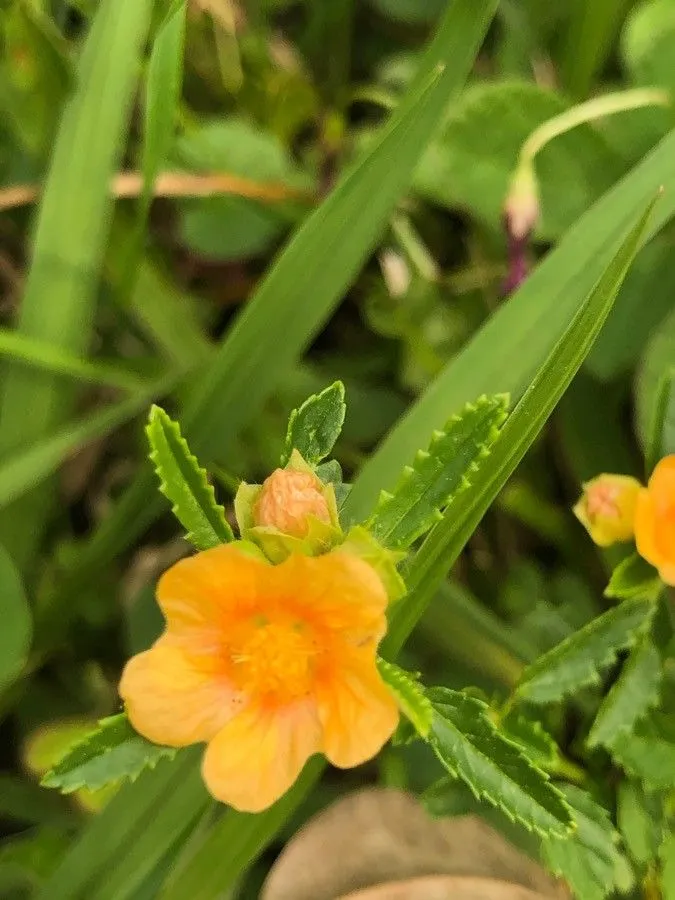
Author: L.
Bibliography: Syst. Nat. ed. 10. 2: 1145 (1759)
Year: 1759
Status: accepted
Rank: species
Genus: Sida
Vegetable: Unknown
Observations: Trop. & Subtrop. America
Bracted Fanpetals (Sida ciliaris)
Bracted fanpetals, scientifically known as Sida ciliaris, is a fascinating species within the Malvaceae family. First described by the botanist Carl Linnaeus in the 10th edition of his comprehensive work “Systema Naturae” published in 1759, this plant has intrigued botanists and plant enthusiasts for centuries.
Geographical Distribution:
This plant thrives predominantly in the tropical and subtropical regions of America. The broad range of its habitat speaks to its adaptability and resilience in various environmental conditions, from coastal areas to inland regions.
Morphological Characteristics:
Sida ciliaris is recognized for its distinctive bracted fan-shaped petals, which lend the plant both its common name and its unique aesthetic appeal. The bracts, modified leaves that resemble small petals, are a key identifying feature. These plants often display a vibrant palette of colors, enhancing their attractiveness and making them a delightful addition to natural landscapes.
Ecological and Practical Importance:
In addition to their ornamental value, plants within the Malvaceae family often play significant roles in their ecosystems. They can provide habitats and nourishment for various pollinators, including bees and butterflies, which are crucial for maintaining ecological balance. Furthermore, the resilience of Sida ciliaris allows it to thrive in challenging environments, contributing to soil stabilization and reducing erosion in its native regions.
Cultivation and Care:
For those interested in cultivating bracted fanpetals, it is essential to mimic their natural habitat conditions to some extent. They prefer well-drained soil and a sunny location, although they can tolerate a range of soil types and light conditions. Regular watering, particularly during dry spells, will ensure healthy growth, though they are relatively drought-tolerant once established.
Conclusion:
In summary, the bracted fanpetals (Sida ciliaris) is a remarkable species that combines ecological importance with aesthetic charm. Its history, stretching back to Linnaeus’s early classification in 1759, underscores its longstanding relevance in the botanical world. Its presence in tropical and subtropical America highlights the rich biodiversity these regions offer, and its characteristics and adaptability make it a plant worth appreciating, both in nature and in cultivated settings.
Eng: bracted fanpetals, bracted sida, fringed fanpetals, fringed sida, salmon sida
Fra: balai-trois-heures, petit balai
Spa: escoba peluda, escoba pestañosa, huinar
En: Bracted fanpetals, Fringed fanpetals, Bracted sida, Fringed sida, Salmon sida
Fr: Balai-trois-heures, Petit balai
Es: Huinar, Escoba peluda, Escoba pestañosa
© copyright of the Board of Trustees of the Royal Botanic Gardens, Kew.
© copyright of the Board of Trustees of the Royal Botanic Gardens, Kew.
© copyright of the Board of Trustees of the Royal Botanic Gardens, Kew.
Taken Dec 22, 2014 by EOL − Annika Lindqvist (cc-by-nc)
Taken Jul 21, 2014 by EOL − Kenneth Bader (cc-by-nc)
Taken Jul 1, 2015 by EOL − Linda Jo Conn (cc-by-nc)
Taken Nov 5, 2019 by schmidt daiane (cc-by-sa)
Taken Jul 7, 2022 by Trap Hers (cc-by-sa)
Taken Jan 1, 1900 by EOL − Forest & Kim Starr (cc-by)
Taken Feb 21, 2011 by EOL − David Eickhoff (cc-by)
Taken Jun 30, 2014 by Thomas Delhotal (cc-by-sa)
Taken Nov 3, 2021 by William Coville (cc-by-sa)
Taken Jan 13, 2014 by Thomas Delhotal (cc-by-sa)
Taken Sep 21, 2016 by Nelson Zamora Villalobos (cc-by-nc)
Taken Sep 21, 2016 by Nelson Zamora Villalobos (cc-by-nc)
Taken Sep 21, 2016 by Nelson Zamora Villalobos (cc-by-nc)
Taken May 24, 2022 by Rodrigo Fernandez (cc-by-sa)
Taken May 24, 2022 by Rodrigo Fernandez (cc-by-sa)
Taken Jul 9, 2016 by Nelson Zamora Villalobos (cc-by-nc)
Taken Sep 21, 2016 by Nelson Zamora Villalobos (cc-by-nc)
Taken Sep 21, 2016 by Nelson Zamora Villalobos (cc-by-nc)
Taken Jan 1, 1900 by EOL − Gibran Morales C. (cc-by-nc-sa)
Family: Myrtaceae Author: (F.Muell.) K.D.Hill & L.A.S.Johnson Bibliography: Telopea 6: 402 (1995) Year: 1995 Status:…
Family: Rubiaceae Author: Pierre ex A.Froehner Bibliography: Notizbl. Bot. Gart. Berlin-Dahlem 1: 237 (1897) Year:…
Family: Sapindaceae Author: Koidz. Bibliography: J. Coll. Sci. Imp. Univ. Tokyo 32(1): 38 (1911) Year:…
Family: Asteraceae Author: A.Gray Bibliography: Pacif. Railr. Rep.: 107 (1857) Year: 1857 Status: accepted Rank:…
Family: Fabaceae Author: Medik. Bibliography: Vorles. Churpfälz. Phys.-Ökon. Ges. 2: 398 (1787) Year: 1787 Status:…
Family: Aspleniaceae Author: (Cav.) Alston Bibliography: Bull. Misc. Inform. Kew 1932: 309 (1932) Year: 1932…